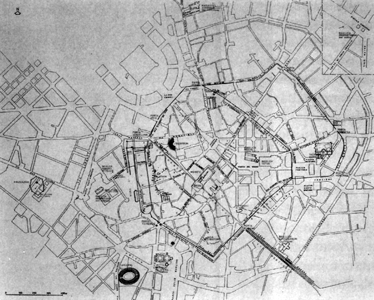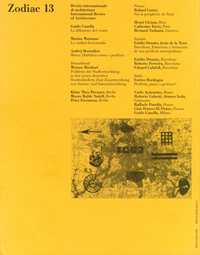You are in: Home page > Magazine Archive > The Spread of the centre
What does it mean to deal with the problem of the periphery? For us, it means first of all understanding the singular essence of the city which has generated it. An essence which cannot be reduced to the generic categorization of a historical landscape to be protected, or a residual space to be modified in keeping with a morphological classification.
It means, therefore, considering — in keeping with a tradition of thought which has stubbornly survived for over a century — each city as a living organism, with an innate respiration, emanated by genetic, physiological heritage across the territory; and this implies that, beyond all appearances, each city possesses a hidden structure — structure and superstructure, as it was once put — a veritable, durable skeleton which supports, as long as it can, a system of cartilage and ligaments; and that only by beginning with this skeleton is it possible to regulate the city, while keeping faith with its true role, in expansion and contraction, in the transformation or conservation of its unity. The occasion for these considerations is, in part, offered by the recent proliferation in Italy of published contributions on urban planning, discussing the different approaches of three generations of master plans developed after the enactment of the town planning legislation of 1942. And yet, beyond any inter-generational accords or contrasts (where the third generation, while historicizing its predecessors, is also busy writing its own autobiography), from our point of view —perhaps because we are not bona fide urbanists — all these plans appear to be substantially comparable, inasmuch as they are applied to the city as if it were a disjointed whole, to be reunited by means of an externally imposed logic, in keeping with models of analysis and prescribed therapy aimed at achieving a kind of conformity: limitation of expansion, safeguarding of the historical centre, reproportionizing of functional facilities according to the rules of zoning and standards, pressure from the peripheries and from suburban overflow, to be channeled into morphological adjustments.
Today we can confidently declare that the correction of urban imbalances envisioned in those master plans has not, for the most part, become a reality. And the cahier de doleances of the Italian urbanists has attributed this failure to a generalized, unpredictable, uncontrollable series of phenomena (industrialization, mass immigration, property values, indiscriminate use of motor vehicles, illegal speculation, election campaign exploitation of issues on the part of politicians and administrators, etc.), and to the lack, or the ambiguity, of the necessary legislative instruments. There is never — at least as far as we know — the minimum suspicion on their part that they may have acted, if only unwittingly, to contribute to the situation, by overlooking the settlement phenomena themselves, beginning with the internal and external imbalances, with certain apparent contradictions which have often been the result of the distancing, the survival and the branching out of the territory.
So the cities have continued to grow, all too often laden with false equilibria, which have ended up breaking the skeleton which, in the meantime, had been scandalously neglected and allowed to weaken. And the urbanists of the third generation, although they profess to be adversaries of the "dominating quantitative model" (derived from the Spanish desarrollismo), now seem to consider the strategic incursions of financial capital, oriented above all toward the abandoned industrial areas of the periphery, above and beyond the control of reason or of present-day disciplinary intervention. Encouraged by the conviction that growth has definitively altered the nature of the city, standardizing its structural peculiarities and reducing differences to pure questions of scale and landscape, the role of urban planning would thus be relegated to the monitoring of the quality of the urban fabric in relation to a presumedly universal model of the city. In fact, precisely toward the end of the third generation, this quality appears to be pursued with new slogans like "the architecture in planning", "interventions of cautious modification", "designing of the urban voids", almost in order to appropriate that analytical-descriptive approach long cultivated in certain schools of Italian architecture, and to definitively exclude architects from the field of urban design. In any case, as a whole, the urban planning culture of all three generations seems to have embodied the contradictions inherent in the most advanced societies, in phases of an inevitable development, adapting to that histoire evenementielle confuted by the "globalist" tradition of historiography where, instead, the differentiated development of each context is extended to include concomitant permanencies and structural beginnings.
What could have been taught, for example and perhaps for analogy, by the urban genesis dualism and the long distance of Henri Pirenne and the long term of Fernand Braudel, propositions of two of the forerunners of that global history?
First, that the essence of the city doesn't stop at its administrative confines, nor at its conurbations, but is extended out into the territory, effecting those other cities and centres with which it establishes a direct and constant relationship of exchange and polarized gravitation. Hasn't the neglect of the priority of a long distance regional transport system, with effectively "urban" frequency of service, travel times, locations, contributed to the phenomena of concentration, land speculation, uncontrolled overflow, obsolescence of services? So much so that even today a decisive manoeuvre of limitation, thinning and requalification of the periphery would have to stimulate an inversion of the settlement trend, with the supply of alternative conditions of living, of employment, of mobility, precisely there where a historical ring of authentic cities could have provided ecological and cultural guarantees. And does not the so-called urban genesis dualism embody, precisely in the bipolar urban regimen of physical discontinuity and "earthport" character, that new settlement order necessary to make the transition of the city, in each structural situation, physiological: in today's structural passage toward the service industries, as in the passage in the past from a feudal to a mercantile society, or from an agrarian to an industrial society?
Without resorting to the historiography of the Franco-Belgian school, direct experience was offered by a certain "polytechnic" urbanistic culture which has developed over time precisely here in Milan (where, moreover, the formula of the three generations was invented), a culture in which there are traces of a tradition of research which, in its approach to the city, has concentrated on extracting, in retrospect, or over the long term, the geneology of the constitution, structural growth and branching of the territory; a geneology against which to measure, precisely in terms of discontinuity, the propulsive consistency of each new project.
From the middle of the last century, with Carlo Cattaneo, to the 1940s and 1950s, with Giuseppe De Finetti, from the post-war period to the present, with Lucio D’Angiolini, there is a timely, cyclical return in this direction, in the form of a debate regarding the decisions in progress: the need to strengthen the identity and the role of the city in its respective context of belonging, the facilitation of productive activities capable of generating well-being for the entire community, the interdependency among the regional capital, the surrounding cities and the concentric bands of expansion, and long-distance trade, using an efficient system of transport and mobility.
A conception which also does justice to a petty dispute between planning norm and architectural exception, shifting the measure of the real contradictions to the dynamic of the macro-economic and macro-urbanistic scale, and thus incorporating certain apparent imbalances nonetheless evident in the necessary transformation of the periphery for that role of functional and figurative importance which can make it recognisable as genuine city.
Guido Canella, architect, was emeritus professor at the Faculty of Civil Architecture of Milan Polytechnic which he helped found. He has taught many times at the IUAV in Venice. He was director of the architectural journal "Hinterland" (1978-85) and the new series of "Zodiac" (1989-2001). He has been a national member of the Accademia di San Luca (since 1989) which he chaired in the years 2007-2008.
*Editorial from issue 13 of the magazione "Zodiac", March / August 1995. Republished by kind permission of the heirs of Guido Canella.

















